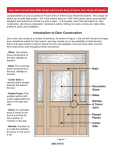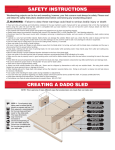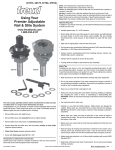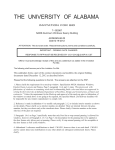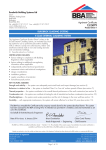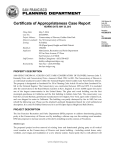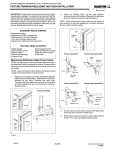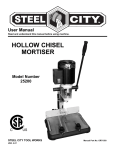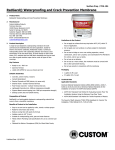Download EDMS Poster-Front
Transcript
Introduction to Door Construction Door units may consist of a number of elements. As shown in Figure 1, the unit will include the hinged door, sometimes called the “door panel,” and may include one or two sidelights to flank the door. Some units also include a transom above the door and sidelights. Here are some other common terms that will be used throughout these instructions: Stiles: The vertical frame components of the door, sidelight or transom. Rails: The horizontal frame components of the door, sidelight or transom. Tenon: An extended piece of wood on the end of a rail that fits into a pocket, or “mortise” in the stile. Mortise: A pocket cut in a stile that matches the tenon on the end of a rail. Glass trim: The wooden molding which holds glass in the door, sidelight or transom. Muntin: The vertical and horizontal elements that divide the glass into smaller sections, or “lights.” Grill: A frame created by joining the horizontal and vertical muntins for a simulated divided light door. Create a Set Up Block. Use a piece of extra material that is milled exactly the same thickness as Figure 6 your stiles and rails to create a Set Up Block. This block should be at least Set Up 10" to 12" long and 6" wide. Be sure it is square and flat, just like your stiles Block and rails. This block will be used for several steps in your door project. • With the router unplugged, install the stile bit in the router. The stile bit is Router Table the largest bit in your set, with one profile cutter and three slot cutters. 9/16" for 1-3/4" Doors • For 1-3/4" stock, set the height of the bit so the lowest slot cutter is 9/16" 1/2" for 1-3/8" Doors above the router table. For 1-3/8" doors, set the bit so the lowest slot cutter is 1/2" above the router table. See Fig.6. • Make the cut in two passes, setting the fence to remove 1/2 of the stock on the first pass. • Make a cut along one edge of the Set Up Block, routing with the grain. • Use a straight edge to align the router table infeed and outfeed fences with the bearing on the bit, then make the second pass. • Check the profile of your Set Up Block. Be sure the bit height was set correctly as described above, and be sure the edge of the workpiece was touching the bearing. If necessary, make any required adjustments to the bit height and fence location and repeat the steps above to make another set up block. • Mark and save this Set Up Block for use in the following steps. ® Stock thickness: 1-3/4" for exterior doors, sidelights and transoms. 1-3/8" for interior doors. Routing the Door, Sidelight & Transom Parts Stile and Rail widths: Note: Traditional French doors usually feature stiles and rails which are wider than are commonly found on doors with wooden panels. We have taken that difference in style into account in the following recommendations. #1 - Full length door panel stiles: Use stiles at least 4-3/4" wide. We recommend 6-1/2" or wider for a true French appearance on doors 36" wide or wider, or 5" or wider on narrower doors. #2 – Transom stiles: should match the door or sidelight stiles that will be located below the transom for the best appearance. #3 - Sidelight stiles: At least 2-1/2" wide. 2 6 4 Figure 1 3 Rails Set Up Block Routing rail ends: a) Install the rail bit into the router collet. b) Set the bit height and make a test cut as follows: • As shown in Figure 7, use your Set Up Block to set the height of the bit. The top of the rail bit’s cutting edge should be level with the horizontal surface of the glass rabbet. • As shown in Figure 8, use the Set Up Block to set the fence position. The tip of the rail bit should be aligned with the vertical edge of the glass rabbet. If you prefer, you can set the fence for a 1/2" width of cut by the rail bit. • Be sure that the fence is parallel to the miter gauge track. • Make a test cut across the end of a test piece of stock by using a miter gauge to feed the stock perpendicularly across the cutter. See Figure 9. 1 Stiles Router Table ® Congratulations on your purchase of Freud’s French Door Router Bit System. This unique set allows you to build high quality 1-3/4" thick exterior doors or 1-3/8" thick interior doors, plus beautiful sidelights and transoms in almost any size or style. With Freud’s 3 Piece Full Light French Door Set you can build beautiful glass doors featuring your choice of glass thicknesses and styles, or even true divided light doors. If you have purchased Freud’s 5 Piece Divided Light French Door Set, you also can build removeable grills for simulated divided light doors, as well as true divided light or full light doors. In this poster, you’ll find information on: door construction; planning & preparation; materials & safety; milling your parts; routing your rails, stiles & joints, building French-style grills; and installation. c) Be sure to obtain enough stock to build the complete door unit, plus extra stock for making test cuts. This will make it easier to match the grain and color of the material for a more attractive finish, and milling all stock to thickness at the same time avoids inconsistencies that can affect the quality of your joints. d) Choose stock with care! Lumber for door construction must be perfectly straight, and free from defects such as knots, splits and checks. Calculating Sizes of Door Parts Figure 7 1/2" FENCE French Door Construction Made Simple with Freud’s French Door Router Bit System Set Up Block Router Table ® Tip 1: Make the opening between the infeed and outfeed fence as narrow as possible (without touching the cutter) to provide maximum support. Tip 2: Use a backer board on the miter gauge to reduce the chance for blow-out at the back end of the cope cut. ® Door and Sidelight Rails: #4 - Top rail: At least 6" wide or wider for a true French appearance. #5 - Bottom rail: At least 10" wide for a true French appearance. #6 - Transom rails: At least 2-1/2" wide. Planning & Preparation a) Contact your local building department to ask about local codes for door construction and installation. The instructions that follow are only intended to illustrate the steps involved in door construction. Your local building codes may have special requirements, particularly in areas that are prone to severe weather. Be sure to obey all local building codes. Note: Product Has Not Undergone DP Rating Procedures. b) Plan the project carefully before purchasing materials. Refer to the reference below for formulas to calculate the widths and lengths of your stiles, rails, and glass inserts. If this is your first door construction project, or if you are building a complex unit with sidelights or a transom, you may find it helpful to draw out the stiles, rails and other elements full size to serve as a construction blueprint. This will serve as a handy reference for calculating and double-checking the sizes of all parts of the project. Note: If the project requires that you build a new door jamb, be sure to allow for the thickness of the jamb elements as you calculate your door and sidelight dimensions. Refer to Special Section 3 for more information on door jamb construction and installation. ® Figure 4 FENCE ® Figure 3 Example: for a 12" wide sidelight with 2-1/2" wide stiles, the calculation is: 12" – 2-1/2" – 2-1/2" + 1" = 8" Rails with extended tenons: Joints that form the corners of the door panel are subject to more stress, so you should use long tenons, as shown in Figure 4. You also may wish to use a longer tenon for joints in your sidelights and transoms for extra strength. The procedure for milling longer tenons will be described in the section to follow. For these high-stress joints of 3'0" wide doors, Freud recommends tenons of at least 2-1/2" length. For 2'8" wide or narrower doors, use at least 2" long tenons. Here are formulas for calculating rail length including these tenons: Multiple Pass Cuts Multiple Pass Cuts RAIL On FACE side of rail, stop making cuts when rail bit reaches SECOND line. On BACK side of rail, stop making cuts when rail bit reaches FIRST line. RAIL On BACK side of rail, stop making cuts when rail bit reaches FIRST line. On FACE side of rail, stop making cuts when rail bit reaches SECOND line. Router Table ® ® Router Table Rails with 2-1/2" Tenons: Rail = door width – (stile width X 2) + 5" Figure 13 Figure 12 Example: for a 36" wide door with 6-1/2" wide stiles, the calculation is: 36" – 6-1/2" – 6-1/2" + 5" = 28" • Final cut with Rail bit: As shown in Fig.13, ON THE FACE SIDE ONLY, make a final pass so that the rail profile aligns with the mark farthest from the end of the rail (this would be the 2-1/2" mark if your tenons are to be 2-1/2" long). • DO NOT MOVE THE FENCE! Unplug the router, remove the rail bit, and install the 22mm mortising bit. Using one of your rails, carefully adjust the height of the mortising bit to match the cuts you made with the rail bit. • Using the miter gauge and backer board, make a final pass across the BACK of each rail, as shown in Fig 14. This cut will create a rail that perfectly matches the stile profile. Rails with 2" Tenons: Rail = door width – (stile width X 2) + 4" Example: for a 32" wide door with 4-3/4" wide stiles, the calculation is: 32" – 4-3/4" – 4-3/4" + 4" = 26-1/2" Glass inserts for doors, sidelights and rectangular transoms: Please note: when ordering glass, be certain that the dimensions provided by the supplier are the actual size of the glass. Some decorative glass suppliers provide dimensions that include an attached frame which is not used in this type of door construction. When ordering any custom glass, be sure to ask the glass supplier for required tolerance in glass sizes. 1/8" Figure 5 Final shape of joint, shown with "haunched," concealed tenon. Face Side RAIL Length/Width Of Glass 1/8" Glass Width = distance between stiles + 3/4" Glass Length = distance between rails + 3/4" See Figure 5. Back Side Face Side FENCE Rail length = sidelight or transom width – (stile width x 2) + 1" Adjust the height of the mortising bit to match tenon you have created with rail bit STILE Face Side RAIL Concealed Tenon Router Table Back Side RAIL or STILE RAIL or STILE 1/2" Figure 14 1/2" Routing Profiles on Stiles & Rails Distance Between Stiles/Rails Mill & Cut Your Door, Sidelight & Transom Parts a) Read and follow all safety instructions that came with these router bits, as well as your planer, saw and all other tools. b) Mill all stock to final thickness. If you do not have a thickness planer, many lumber dealers and millwork shops will plane stock for a fee. Note: If you plan to make a true divided light door you should also mill and cut stock for your muntins at this time. Read Special Section 2 on the back of this poster before proceeding. c) Rip all stock to finished width. See recommended widths in the previous section. Be sure all edges are perfectly square, and that all surfaces are straight and flat. Freud’s LM72R series or LU87R series ripping blades are excellent choices for this thick stock. d) Cut all parts to length, using the formulas in the previous section. Tip 1: Determine the best or “face” side of all components and use a pencil to label each component on the back. Note: Because door and sidelight stiles and transom rails are very long and heavy, you must take extra care in the set up of your router table. Be sure that the router table is stable and will not tip over in use. Provide support for the work piece on both the infeed and outfeed side of the table. Adjustable roller stands are an excellent choice for infeed and outfeed support. Use two or more featherboards, such as Freud #BF3510, to hold the workpiece down on the table and in against the fence. With the router unplugged, install the stile cutter. Setting the cutter height and making a test cut. • Use the Set Up Block as a guide to set the cutter height, as shown in Fig. 15. • Make a test cut on scrap material. Compare this scrap material to a rail end to be sure the bit height is correct. Adjust as necessary. . • Note: Make the cut in two passes, setting the fence to remove 1/2 of the stock on the first pass. Continued on reverse side... FENCE - Use router bits with a router only. - Carbide is a very hard and brittle material. Slight shocks can damage the carbide. Before each use, check that the bit is sharp and free from damage. DO NOT use the bit if it is dull, broken, cracked or if any damage is noticed or suspected. - Before each use, make sure that at least 80% of the router bit shank is inserted into the collet. The end of the bit shank should be at least 1/8" from the bottom of the collet. - Before each use, ensure that the collet has been tightened and that the work piece is secure. - Read and obey all warnings and instructions contained in the router’s user’s manual, and for any accessory that is used. If you do not have the correct user’s manual, obtain one from the manufacturer before using the router bit. - Always wear eye protection or a full face shield complying with current ANSI Standard Z87.1. - Keep body, clothing and hair clear of spinning bit. Do not wear loose hanging clothing or jewelry. - Use a router table and fence wherever possible. Be sure all guards are in place. - Bits over 1-1/2" in diameter must only be used with the router mounted in the table. - Use multiple passes when removing large quantities of material. - Never use bit on router that will exceed maximum recommended RPM of bit. - If you have any questions regarding your router bits, please call Freud Customer Service at 800-472-7307. In Canada call 800-263-7016. - Before making any structural alterations to your home, consult a licensed general contractor, licensed architect or professional engineer. - Be sure to consult your local building authority before proceeding with your door project. - Keep these instructions in a safe place for future reference. 2-1/2" Long Extended Tenon Set Up Block Router Table ® ! WARNING: Failure to obey these warnings could lead to serious bodily injury or death: 1/2" Long Stub Tenon ® Creating your own French door is a fun and rewarding woodworking project that enables you to add curb appeal or distinction to any door of your home. As with any woodworking project, however, your first concern must always be safety. To get the best performance and results from your Freud cutting tools, observe these safety recommendations for EACH operation: - Make sure that you are well rested before working with power equipment. - Do not use power equipment if you have consumed any drugs or alcohol. If you are taking prescription medication, check with your physician to ensure it is safe for you to operate power equipment. - Never use a router bit that is damaged or dull. - Always turn off and unplug the router before removing, installing or adjusting bits, adjusting the router or fence, or assembling or disassembling bits. Rails with stub tenons: For joints in your sidelights and transoms that will not be subjected to great stress, you may wish to make stub tenons as shown in Fig. 3. This joint lacks the strength of the mortise and tenon, but it is quicker and easier to produce, and will be fine for joints that are not subjected to great stress. Here is a formula for calculating the length of rails with these stub tenons: Figure 9 d) Routing rail ends with long tenons: For any rails that will have long tenons, including all door rails, use Make Second Mark Here Back Side the following procedure: • As shown in Figure 10, carefully mark the overall length of your tenons on both edges of each rail. Make a second mark 1/2" closer to the end of the rail. For example, if your tenons will be 2-1/2" long, put marks at 2-1/2" and 2" from the end of each rail. • Be sure that the fence is parallel to the miter gauge track, then rout Mark Overall Length of Tenon Here Face Side across each rail end using the same procedure described for routing the stub tenons. • After routing each rail face down, turn the rail over and repeat the cut Face Side with the stock face up, as shown in Figure 11. • Second pass: Long tenons should be routed in multiple passes. Move the fence back 1/2" from the position used for the first pass. Use a miter First Pass Cut gauge, and with the good or “face” side of the rails facing down; make the rail end cut on one side of each end of all rail parts that are to have Router Table long tenons. Turn the stock over and make the rail end cut on the other side of each rail. • Move the fence back in increments of not more than 1/2" and repeat Figure 11 the procedure described for the second pass. Continue this process until the bit cuts to the first pencil mark. IMPORTANT: Stop routing when the rail bit reaches the first mark, as shown in Fig. 12. FENCE Safety Tips Rail lengths: Are determined based on the width of the stiles and the length of the tenon you plan to use. ® In addition to the Freud French Door router bits, you will need the following tools and supplies to build your door unit: - Variable speed router, 2-1/4 HP minimum, 3-1/4 HP preferred. - Router table with fence, miter gauge and two or more featherboards. We also strongly recommend that a shop vacuum or dust collector be used with the router table. - Table saw for ripping stiles, rails and other door parts. - Infeed and outfeed stock supports such as roller stands or similar devices to support long boards. - Mortising machine, Drill Press with mortising attachment, or Drill Press with brad point bits. - Various common woodworking hand tools including hammer, chisels, rule, straight edge, square, coping saw. - Clamps with the capacity to secure all door joints. - A sturdy, level work table or saw horses for door assembly. - Lumber for door parts (and door jamb, if required). - Exterior wood glue. - Glass. - Sealant or glazing tape for glass installation. Table 1/2" Figure 10 Stile lengths: Should be equal to the finished height of the door, sidelight or transom. Materials Required FENCE Router c) Making the rail end cuts: • If you need only a stub tenon for sidelight parts, you need only make a single cut across each rail end, as you did with the test piece in the previous step. With the good or “face” side of the rails facing down; make the rail end cut on each end of all rails, just as you made the test piece. Rails for stub tenons are now complete. Figure 2 FENCE Mortise & Tenon Joints • Test the fit of your test piece against the profile of your Set Up Block. The two should match perfectly. If they do not, unplug the router and adjust the height of the bit or position of the fence as needed. Then follow the procedure above until your joint fits perfectly. 5 Muntins or Grill Figure 8 Figure 15 Finish the Mortise & Tenon Joints a) First, carefully “haunch” the tenons as shown in Figure 16. This step produces a stronger and more attractive joint and conceals the tenon within the end of the stile. Cut the haunched tenon with a band saw, jig saw or handsaw. b) For wide tenons such as those in the bottom rails, divide the tenon into two parts as shown in Figure 17. Using a band saw, jig saw or coping saw, cut a 1-1/2" space between the tenons. c) Lay out and cut mortises in the door stiles to accept the tenons. The tenon should fit snugly into the mortise. There are several ways to cut mortises: • The easiest method is to use a mortiser or drill press mortising Figure 16 Figure 17 attachment. Use a 5/8" hollow chisel mortising bit for 1-3/4" exterior doors, or a 3/8" hollow chisel mortising bit for 1-3/8" doors. If your mortiser will not accept 5/8" chisels, make multiple cuts with a smaller chisel. • If you don’t have a mortiser or mortising machine, an alternative technique is to use a brad point bit or forstner bit (5/8" diameter for exterior doors, 3/8" for interior doors) in a drill press to remove most of the stock for the mortise, and then use a chisel to remove the remaining stock and to “square up” the mortise. Carefully center the brad point bit in the groove and drill only about 1/16" deeper than required for the tenon. • A third mortising technique combines the use of the drill press and brad point or forstner bits with Freud straight router bits to finish, or “clean out”, the mortise. First, use a brad point or forstner bit (5/8" diameter for exterior doors, 3/8" for interior doors) to remove most of the stock for the mortise. Drill the holes as close together as possible. Take care to be sure the holes are perfectly centered in the groove of the stile. Next, build a simple mortising jig as shown below in Figure 18 and 19. 1/2” collet plunge router Stop Block Stop Block to control length of mortise. Stop Block to control length of mortise. Add filler strip to guide bit on back of stile. First pass to clean mortise –no more than 1" deep. (use Freud # 12-116) Full depth of mortise predrilled to 2-1/2" using forstner or brand point bit. Final pass to clean mortise. Use Freud # 12-128 for 2-1/2" deep mortises. Stile Full depth of mortise predrilled to 2-1/2" using forstner or brand point bit. Stile 1-1/2” thick blocks, cut to match stile width, cut from 2x6 stock. Figure 18 Figure 19 Clamp the stile securely between the sides of the jig. As shown in the illustration, you must create a “filler strip to serve as a bit guide on one side of the jig. You also must attach stops to the top surface of the jig to control how far the router will rout the mortise, as shown. Now, use Freud straight router bits to carefully remove the remaining stock in the mortise. As shown in the illustration, the smooth portion of the shank of the bit will follow the inside of the groove and act as a guide for the router. This may produce a slight burn on the inside surface of the stile groove, but this is concealed when the door is assembled. Depending on the depth of your mortise, you will need to use two or more different bits to reach the full depth. Please see the illustration for more details. Assembling the Door, Sidelight and Transom Installing Glass in the Door Unit FENCE Mill wooden glass stop. For best appearance, mill the stop from the same material used for the door. In many cases, you may have enough scrap stock left when you rip your stiles and rails to finished width to make the glass stop. Replace Slot Cutters with Spacers Important: Use feather boards to hold stock down and against fence. ® R o u t e r Ta b l e Figure 20 Note: For safety, rout the glass stop from material larger than the finished size of the stop, then rip to finished size on the table saw, as shown in Figure 21. RAIL or STILE Figure 25 RAIL or STILE Figure 26 Length of Muntins b) Cut your muntins to length. Vertical muntins should be exactly the length of the distance between the shoulders of the profiles routed on the top and bottom rails, as shown in Fig. 26. Horizontal muntins should be the length of the distance between the shoulders of the profiles routed on the vertical stiles. c) Lay out the spacing of the “lights” that you want the grill to form. The most common pattern for a 3'0" x 6'8" French door is 15 lights, but you can create a grill in any stile you desire. Mark the center of each joint on each vertical and horizontal piece. d) Install the Muntin joint bit in the router. Adjust the height to match the height of the stile profile on your Set Up Block. If the grill will go on the side of the door where you installed glazing tape, you will need to raise the bit higher to account for the thickness of the tape. e) First, rout a cope profile on the end of a scrap piece of muntin stock. Use your Set Up Block to position the fence, as shown in Fig 27. Using your miter gauge with a backerboard to prevent blowout, make a cut across a piece of scrap muntin stock. Set Up Check to be sure it matches the profile on the door’s styles and rails. Adjust the fence Block or bit height as needed, and make more test cuts until you get a perfect fit. f) Rout the cope profile on both ends of each muntin. Router Table g) DO NOT CHANGE THE HEIGHT OF THE BIT. Remove the router table fence. Make a simple jig to attach to your miter gauge to control the spacing of the Figure 27 intersection joints, as shown in Fig. Figure 28 28. The jig must include a backer Backer Stop board to prevent blowout. Rout each Board intersection joint in the horizontal Section A-A Backer muntins. Push the muntin across the Horizontal Muntin Miter Board bit, holding the muntin securely down Muntin Rout Face Side Up Gauge Miter Joint Bit on the table and against the Stop Gauge backerboard. DO NOT pull the jig and muntin back across the spinning R outer Table router bit! Allow the bit to stop before A A returning the jig to the starting position. h) Now change to the straight bit to rout the matching slots in the vertical Figure 29 muntins. Using the miter gauge with Backer Spacer a backerboard, carefully rout each Board slot as shown in Fig. 29. Make test Vertical Muntin Section A-A Backer cuts in scrap stock first to test the fit. Rout Face Side Down Miter 1/4" Board The jig shown in Fig. 30 will allow Gauge 1/4" Straight Miter you to produce an even spacing. Straight Bit Spacer Gauge Bit i) Assemble the grill using glue and small spring clamps, and allow to dry. R outer Table j) The SDL grill may be attached in A A two ways. For a permanent installation, grills can be glued and tacked in place with brads, using care not to hit the glass with the brad. For Position spacer to match layout of horizontal muntins. removable grills, small spring clips can Spacer, sized to match top bead of muntin 1/4" be purchased from various suppliers. profile. Attach spacer Straight Contact a local door and window to backer board. Bit End View supplier to locate clips. These clips slip behind the glass trim and hold the grill in place. For clip suppliers, please R o u t e r Table visit freudtools.com. Be sure to read and follow all of the safety instructions included with your table saw. If you are uncertain about safe procedures for ripping narrow pieces of molding, consult your saw supplier or manufacturer before proceeding. If you choose to build French Doors with true divided light grills, the procedures are very similar to milling and joining stiles and rails. For best results, mill stock for the muntins at the same time that you mill stock for stiles and rails. Then rout tenons and stile profiles while you rout the rails and stiles for your door. Routing all parts at the same time will save time, and improve the accuracy of the joints. a) Plan the muntin arrangement. The most common design for French doors is a “15 Light” design, which includes two vertical and four horizontal muntins (see Fig. 1). You can alter this design in any way you choose. b) Calculate muntin sizes and lengths. Muntins will be the same thickness as your stiles and rails: 1-3/4" for exterior doors or 1-3/8" for interior doors. Muntins for true divided light should be at least 1-1/2" wide, as shown in Fig. 31. Horizontal muntins will be the same length as the door rails. Vertical muntins will be cut to fit between the horizontal muntins. The length of the vertical muntins depends upon the width of your muntins and the spacing between them. For best results make a test joint before cutting vertical muntins to length – this will help you make accurate calculations of the length of the vertical parts. Be sure to allow for the length of the tenons when you cut vertical muntins! c) Cut “blanks” for your muntins. These blanks will be the finished length of your muntins, but wide Figure 31 enough to create several muntins. Using this technique makes it easier to rout your tenons accurately. 1-1/2" d) Rout long tenons on horizontal muntins as you rout the long tenons on your door rails, as shown in the section titled “Making the Rail End Cuts” on the other side of this poster. Tenons on horizontal muntis 1/2" will be the same length as the tenons on the door rails. e) Rout tenons on your vertical muntins using the same procedure, but these tenons will not need to be as long. As shown in Fig. 32, the tenons should meet in the center of the horizontal muntins. Vertical Muntin RAIL Tenons on vertical muntins meet in center of horizontal muntins Vertical Muntin Vertical Muntin Special Section 1: Building Grills for Simulated Divided Lite Doors If you purchased a set containing Freud’s unique Muntin Joint Bit and a 12-100 1/4" diameter straight bit, you have all the bits you need to make beautiful French-style simulated divided light (SDL) grills. If you have a 3 Piece Full Light French Door set, you can easily obtain the muntin joint and straight bits from your Freud dealer. a) First, mill the stock for your muntins. To get perfect intersection joints in your grills, you need to mill this stock to precisely the same width as the diameter of the Muntin Joint Bit, as shown in Fig. 23. The thickness of your muntins is determined by the distance from the surface of the glass to the surface of the door’s stiles and rails, as shown in Fig. 24. Figure 32 Horizontal Muntins Horizontal Muntins f) Rout the stile profile on the edge of each of your 1/2" thick spacer on outfeed muntin blanks. Use the technique described in the side of fence supports muntin. section entitled “Routing Profiles on Stiles and Rails.” Then rip off the routed edge to the finished width of the muntin. Carefully rout the stile profile Figure 33 on the other edge of the muntin. As shown in Fig. 33, you must attach a 1/4" thick spacer to the outfeed fence of your router table to reduce the R o u t e r Ta b l e Router Table chance of the muntin tipping. Note: you must use a pusher stick to feed the workpiece, and featherboards to hold stock against the fence and Notes: down against the router table. Continue to rout 1 - Use push stick to feed stock. Keep hands clear! one edge of the blank, rip the muntin to width, 2 - Use featherboards (not shown) to hold muntin then rout the other edge, until all muntins are down on table and against fence completed. g) Lay out and cut mortises, using the same mortise procedure you use for the stile and rail joints. You will cut mortises in the stiles and rails to match the layout of your muntins. You also will cut mortises through the horizontal muntins to accept the tenons of the vertical muntins. See the section entitled “Finishing the Mortise and Tenon Joints” for more information on mortising. OUTFEED FENCE d) Carefully fit the wooden glass stop in the opening, mitering the corners of each piece. Install the glass stop using finish nails or screws. Be sure to predrill the stop, and use great care to avoid hitting the glass with the fasteners or your drill, screwdriver or hammer. Elements of the Door Frame Figure 34 Header Hinge Jamb / Mullion Sill/Threshold a) Sill or threshold: This is the horizontal element that forms the base of a door frame. This is usually found only on exterior door units. Interior door frames are usually open at the base, allowing the flooring material to go through the opening. The sill or threshold on exterior doors provides a seal to prevent air and moisture from coming under the door, and is angled to shed water away. b) Header: This is the horizontal element that forms the top of the door frame. c) Sides, or “Hinge Jamb” and “Strike Jamb”: Vertical elements that form the sides of the door frame. d) Mullion or Mull Post: Vertical element that stands between the door panel and the sidelights. Door frame parts are commonly available at lumberyards and home centers. If you have trouble finding suitable door frame parts locally, refer to the supplier list at freudtools.com. Note: If you are building a frame for an exterior door, be sure to purchase frame parts that include weatherstripping, or add weatherstripping yourself after installation. • Assemble the frame first on a flat surface, then install your door frame securely in the wall opening. A poorly constructed or installed door frame will affect the appearance and function of your new door panel. • For interior doors, nails can be used to assemble the frame and attach it to wall framing. • For exterior doors, stainless steel or galvanized screws are the preferred fasteners. • When installing exterior door frames, put a generous amount of caulking under the threshold or sill in continuous beads to prevent water from seeping between the sill and subfloor or slab. • Be sure that all vertical elements are perfectly “plumb,” or vertical, all horizontal elements are level, and all corners of the frame are square. • Because “rough” door openings in walls are commonly a little larger than the finished size of the door frame, there may be space between the door frame and the wall framing. Be sure to fill this space with wooden shim shingles at all fastener locations. Be especially careful to shim solidly at the locations of hinges and locks, as these points are most prone to failure. • Consult your building department for complete requirements for door framing, required fastening systems, insulation, wind resistance and other local regulations. Installing, or “hanging” a door panel in an existing frame: If you are replacing a door panel in an existing door frame, you may be able to use the hinges that are already in place. Follow these steps: Special Section 2: Building True Divided Lite Doors INFEED FENCE Note: Wear safety glasses and protective gloves when handling glass. If you are unfamiliar with handling glass, consult your glass supplier for complete information on proper safety procedures before proceeding. Note: Before building or installing a new door frame, contact your local building department to ask about applicable local codes. The instructions that follow are only intended to illustrate the key aspects of door frame construction. Your local building codes may have special requirements, particularly in areas that are prone to severe weather. Special Section 4: Installing Door Hinges & Hardware Glazing Tape b) As shown in Figure 22, apply 1/16" or 3/32" thick glazing tape to the face of the glass rabbet. Apply the tape on all four sides of the opening, and fit the tape carefully to avoid gaps. Apply sealant to the joints between the sections of tape. Refer to the instructions that came with the tape for recommended sealants and complete installation instructions, or check with the tape Figure 22 supplier for more details. c) Carefully place the glass in the opening against the glazing tape. Follow the tape manufacturer’s recommendations carefully to ensure a good seal! If you are simply replacing the door panel or even the sidelights and transom of an existing door unit, you may be able to use the door frame that already is in place. Check the door frame carefully for any signs of rot or other damage. If it is in good condition, you need only build your new door panel and other parts to fit. If you need to construct a new door frame, refer to the following instructions and illustrations: a) Remove the existing hinges and any other protruding hardware from the door frame. b) Carefully fit your new door panel into the opening. Many existing door frames may be slightly out of plumb, or the header may be out of level, due to normal shifting and settling of the building. Slowly and carefully plane, cut or sand the edges of the door panel until it matches the shape of the frame. The door should slip easily into the opening, but it should not be loose. c) With the door standing in the frame and pressed snugly against the hinge side and the header, mark the locations of the existing hinge mortises. d) Cut mortises for your hinges in the edge of your door panel so the surface of the hinge is flush with the surface of the door or frame. You can cut hinge mortises with a sharp chisel, but a faster method is to use a hinge mortising jig with your router and a Freud router bit. Freud has a selection of mortising bits to work with all common jigs. e) Reinstall the hinges on the door jamb. Install the hinges in your door panel. (Be sure to predrill the holes!) f) Carefully align the two matching leaves, or “butts” of each hinge and install the hinge pins. Start with the top hinge and work downward. g) If necessary, mark and trim the latch side of the door so it closes easily with a gap of not more than 3/32" between the door panel and jamb. Installing a door panel in a new frame: If you are hanging a door in a new door frame, follow these steps: For doors up to 6'8" tall, you will need to use three hinges. Taller doors should be hung on at least four hinges. For exterior doors, 4" hinges are recommended. 3-1/2" hinges are acceptable for most interior doors. “Butt” style hinges with loose pins are easily found at any lumberyard, home center or hardware store in a variety of sizes and finishes. a) Carefully fit your new door panel into the opening. If both your door panel and door frame are perfectly square and correctly dimensioned, this should not be difficult, but slight corrections are not unusual. Slowly and gradually plane, cut or sand the edges of the door panel until it matches the shape of the frame. b) With the door standing in the frame and pressed snugly against the hinge jamb and the header, mark the locations of the hinges on both the frame and the door panel. Hinges should be placed so the top edge of the upper hinge is 5" to 7" from the top of the door, the bottom edge of the bottom hinge should be 7" to 9" from the bottom of the door, and one or more hinges should be evenly spaced in between. c) Cut mortises for your hinges in the edge of your door panel and door frame, so the surface of the hinge is flush with the surface of the door or frame. You can cut mortises with a chisel, but a faster method is to use a hinge mortising jig with your router and a Freud router bit. Freud has a selection of mortising bits to work with all common jigs. d) Install the hinges in the door jamb and in your door panel. (Be sure to predrill the holes!) Carefully align the two matching leaves, or “butts” of each hinge and install the hinge pins. Start with the top hinge and work downward. e) If necessary, mark and trim the latch side of the door so it closes easily with a gap of not more than 3/32". Installing a lockset: When you purchase a lockset it should include detailed installation instructions, as well as templates to lay out hole locations. Hole sizes and patterns vary for different manufacturers and lock styles, so follow the instructions with care. If instructions were not included with the lockset you purchased, return it or contact the manufacturer before proceeding. ® Figure 21 Length of Muntins Figure 30 a) Be sure to dry fit all parts of each element of the door unit before applying any glue. Be certain that all joints will close completely, and that the door will be flat and square when assembled. Plan your clamping procedure in advance, and be sure you have enough clamps on hand to secure all joints. b) Carefully apply glue to the tenons, the ends of all rails, and the matching locations on the stiles. With the door panels in place, assemble the entire door and clamp all joints. c) Allow the glue to cure at least 24 hours, or longer if recommended by the glue manufacturer. d) Remove all clamps and carefully sand both sides of the door, sidelights and transom. a) We suggest that you use the stile bit from your French Door Set to mill the glass stop. For safety, remove the three slot cutters from the stile bit, and replace them with the spacers that were included with your set. Retighten the nut securely. Begin with a piece of stock at least 9/16" thick and wide enough to safely handle in routing and sawing operations. Rout the stile profile carefully, using featherboards to control the workpiece, and observing all of the safety procedures in those instructions. If your stock is wide enough, rout both edges to produce two pieces of glass stop as shown in Figure 20. Special Section 3: Building & Installing the Door Frame, or “Jamb” ® Bit shank acts as guide Stock for Muntins Muntins ® 1/2” collet plunge router Groove router with Muntin joint bit. Muntins FENCE Tip 1: Before routing, mark which edges of each part should be routed to help avoid mistakes. 1-1/8" h) Carefully “dry fit” all muntin parts along with your stiles and rails to check the fit. i) Once your fit is correct, assemble all door parts as suggested in the section entitled “Assembling the Door, Sidelights and Transom.” j) Install multiple glass lights using procedure described in the section entitled “Installing Glass in the Door Unit.” ® Making the stile or profile cuts. • With the good side of the rails and stiles facing down, rout the stile profile on one edge of each rail and stile part. Use two passes to make these cuts, just as you did when routing your test piece. Thickness of muntins should match distance from glass to face of stiles and rails. Figure 24 Figure 23 ® Routing Profiles on Stiles & Rails...continued. Tip: To make a simple gauge to check the width of your muntins, use the muntin joint bit to rout a groove in a piece of scrap stock, as shown in Fig. 25. As you plane or cut your muntins to the proper thickness, use this gauge to check for accuracy. The stock for the muntins should slip snugly into the groove in your gauge. ® ! WARNING!: Read all safety warnings on the other side of this poster before proceeding. To find out more about Freud products or to order a catalog visit: www.freudtools.com Freud America, Inc. 1-800-472-7307 (U.S.) 1-905-670-1025 (Canada) ©2007 Freud America, Inc. No portion of this piece may be reprinted without the written consent of Freud America, Inc. The color Red on router bits and saw blades is a US Registered Trademark of Freud America, Inc.


